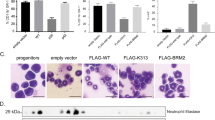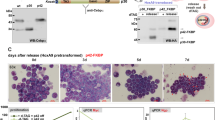Abstract
Heterozygous mutations of the CEBPA gene are present in 5% of acute myeloid leukemia (AML) cases and often lead to the expression of an N-terminally truncated, 30 kDa isoform, C/EBPαp30, from an internal translation start site. We have assessed the effect of C/EBPαp30 on granulopoiesis utilizing C/EBPαp30-ER, containing the estradiol receptor ligand-binding domain. In contrast to C/EBPα-ER, C/EBPαp30-ER did not induce 32Dcl3 myeloid cell differentiation in IL-3. However, both isoforms, when expressed at high levels, were capable of inhibiting E2F activity in 32Dcl3 cells and of slowing their G1 to S progression. C/EBPαp30 repressed expression of the endogenous G-CSF receptor several-fold. To facilitate investigation of the effect of C/EBPαp30-ER on granulopoiesis downstream of G-CSF signalling, we coexpressed exogenous G-CSF receptor. C/EBPαp30-ER/GR cells expressed several granulocytic markers in G-CSF and demonstrated nuclear maturation. Rat C/EBPα-ER and C/EBPαp30-ER, expressed in 293T cells, bound the C/EBP site from the NE gene with similar affinity, as did human C/EBPα and C/EBPαp30. In contrast, C/EBPαp30 bound the C/EBP sites in the PU.1 or GR gene with 3–6-fold reduced affinity. Thus, the selective inhibition of GR expression by C/EBPαp30-ER is due in part to its variable affinity for C/EBP sites. Variation in affinity for selected cis elements among isoforms may affect the biology of basic region-leucine zipper (bZIP) proteins.
This is a preview of subscription content, access via your institution
Access options
Subscribe to this journal
Receive 50 print issues and online access
$259.00 per year
only $5.18 per issue
Buy this article
- Purchase on Springer Link
- Instant access to full article PDF
Prices may be subject to local taxes which are calculated during checkout







Similar content being viewed by others
References
An MR, Hsieh CC, Reisner PD, Rabek JP, Scott SG, Kuninger DT and Papaconstantinou J . (1996). Mol. Cell. Biol., 16, 2295–2306.
Birkenmeier EH, Gwyenn B, Howard S, Jerry J, Gordon JI, Landschulz WH and McKnight SL . (1989). Genes Dev., 3, 1146–1156.
Britos-Bray M, Ramirez M, Cao W, Wang X, Liu PP, Civin CI and Friedman AD . (1998). Blood, 92, 4344–4352.
Calkhoven CF, Muller C and Leutz A . (2000). Genes Dev., 14, 1920–1932.
Christy RJ, Yang VW, Ntambi JM, Geiman DE, Landschulz WH, Friedman AD, Nakabeppu Y, Kelly TJ and Lane MD . (1989). Genes Dev., 3, 1323–1335.
Descombes P and Schibler U . (1991). Cell, 67, 569–579.
Diehl AM, Michaelson P and Yang SQ . (1994). Gastroenterology, 106, 1625–1637.
Friedman AD . (1996). Cancer Res., 56, 3250–3256.
Friedman AD . (2002a). Oncogene, 21, 3377–3390.
Friedman AD . (2002b). J. Cell. Biochem., 86, 624–629.
Friedman AD, Landschulz WH and McKnight SL . (1989). Genes Dev., 3, 1314–1322.
Friedman AD and McKnight SL . (1990). Genes Dev., 4, 1416–1426.
Gombart AF, Hofmann WK, Kawano S, Takeuchi S, Krug U, Kwok SH, Larsen RJ, Asou H, Miller CW, Hoelzer D and Koeffler HP . (2002). Blood, 99, 1332–1340.
Iwasaki-Arai J, Zhang P, Huettner CS, Fenyus M, Lekstrom-Himes J, Tenen DG and Akashi K . (2002). Blood, 100, 61a.
Johansen LM, D'Alo' F, Nelson EA, Radomska HS, Evans EK, Zhang P, Nerlov C and Tenen DG . (2003). Blood, in press.
Keeshan K, Santill G, Corradini F, Perrotti D and Clabretta B . (2003). Blood, 102, 1267–1275.
Kummalue T and Friedman AD . (2003). J. Leuk. Biol., 72, 464–470.
Landschulz WH, Johnson PF and McKnight SL . (1989). Science, 246, 1681–1688.
Lin FT, MacDougland OA, Diehl AM and Lane MD . (1993). Proc. Natl. Acad. Sci. USA, 90, 9606–9610.
Liu H, Keefer JR, Wang Q and Friedman AD . (2003). Blood, 101, 3885–3892.
Lou J, Cao W, Bernardin F, Ayyanathan K, Rauscher III FJ and Friedman AD . (2000). Oncogene, 19, 2695–2703.
Nuchprayoon I, Meyers S, Scott LM, Suzow J, Hiebert S and Friedman AD . (1994). Mol. Cell. Biol., 14, 5558–5568.
Oelgeschläger M, Nuchprayoon I, Luscher B and Friedman AD . (1996). Mol. Cell. Biol., 16, 4717–4725.
Pabst T, Mueller BU, Zhang P, Radomska HS, Narravula S, Schnittger S, Behre G, Hiddemann W and Tenen DG . (2001). Nat. Genet., 27, 263–270.
Porse BT, Pedersen TA, Xu X, Lindberg B, Wewer UM, Friis-Hansen L and Nerlov C . (2001). Cell, 107, 247–258.
Radomska HS, Huettner CS, Zhang P and Tenen DG . (1998). Mol. Cell. Biol., 18, 4301–4314.
Rangatia J, Vangala RK, Treiber N, Zhang P, Radomska H, Tenen DG, Hiddemann W and Behre G . (2002). Mol. Cell. Biol., 22, 8681–8694.
Raught B, Liao WS and Rosen JM . (1995). Mol. Endocrinol., 9, 1223–1232.
Reddy VA, Iwama A, Iotzova G, Schulz M, Elsasser A, Vangala RK, Tenen DG, Hiddemann W and Behre G . (2002). Blood, 100, 483–490.
Scott LM, Civin CI, Rorth P and Friedman AD . (1992). Blood, 80, 1725–1735.
Smith LT, Hohaus S, Gonzalez DA, Dziennis SE and Tenen DG . (1996). Blood, 88, 1234–1247.
Suzow JG and Friedman AD . (1993). Mol. Cell. Biol., 13, 2141–2151.
Theilgaard-Moench K, Ungermand C, Damgaard I, Rasmussen T, Verbeek W, Jacobsen SE, Borregaard N and Porse B . (2002). Blood, 100, 298a.
Umek RM, Friedman AD and McKnight SL . (1991). Science, 251, 288–292.
Valtieri M, Tweardy DJ, Caracciolo D, Johnson K, Mavilio F, Altmann S, Santoli D and Rovera G . (1987). J. Immunol., 138, 3829–3835.
Wang H, Iakova P, Wilde M, Welm A, Goode T, Roesler WJ and Timchenko NA . (2001a). Mol. Cell, 8, 817–828.
Wang X, Scott E, Sawyers CL and Friedman AD . (1999). Blood, 94, 560–571.
Wang W, Wang X, Ward A, Touw I and Friedman AD . (2001b). Leukemia, 15, 779–786.
Wang QF, Cleaves R, Kummalue T, Nerlov C and Friedman AD . (2003). Oncogene, 22, 2548–2557.
Wang QF and Friedman AD . (2002). Blood, 99, 2776–2785.
Yen J, Wisdom RM, Tratner I and Verma I . (1991). Proc. Natl. Acad. Sci. USA, 88, 5077–5081.
Zhang DE, Zhang P, Wang ND, Hetherington CJ, Darlington GJ and Tenen DG . (1997). Proc. Natl. Acad. Sci. USA, 94, 569–574.
Zhang P, Iwama A, Datta MW, Darlington GJ, Link DC and Tenen DG . (1998). J. Exp. Med., 188, 1173–1184.
Acknowledgements
We thank D Tenen, B Porse, and C Nerlov for plasmids and C Stocking for her comparison of rat, mouse, and human C/EBPα sequences. This work was supported by NIH Grant R01 HL51388. ADF is also supported by the Children's Cancer Foundation and is a Scholar of the Leukemia & Lymphoma Society.
Author information
Authors and Affiliations
Corresponding author
Rights and permissions
About this article
Cite this article
Cleaves, R., Wang, Qf. & Friedman, A. C/EBPαp30, a myeloid leukemia oncoprotein, limits G-CSF receptor expression but not terminal granulopoiesis via site-selective inhibition of C/EBP DNA binding. Oncogene 23, 716–725 (2004). https://doi.org/10.1038/sj.onc.1207172
Received:
Revised:
Accepted:
Published:
Issue Date:
DOI: https://doi.org/10.1038/sj.onc.1207172
Keywords
This article is cited by
-
Homodimer-mediated phosphorylation of C/EBPα-p42 S16 modulates acute myeloid leukaemia differentiation through liquid-liquid phase separation
Nature Communications (2023)
-
The splicing factor RBM25 controls MYC activity in acute myeloid leukemia
Nature Communications (2019)
-
C/EBPα in normal and malignant myelopoiesis
International Journal of Hematology (2015)
-
Pharmacological targeting of the Wdr5-MLL interaction in C/EBPα N-terminal leukemia
Nature Chemical Biology (2015)
-
Expression of different functional isoforms in haematopoiesis
International Journal of Hematology (2014)



